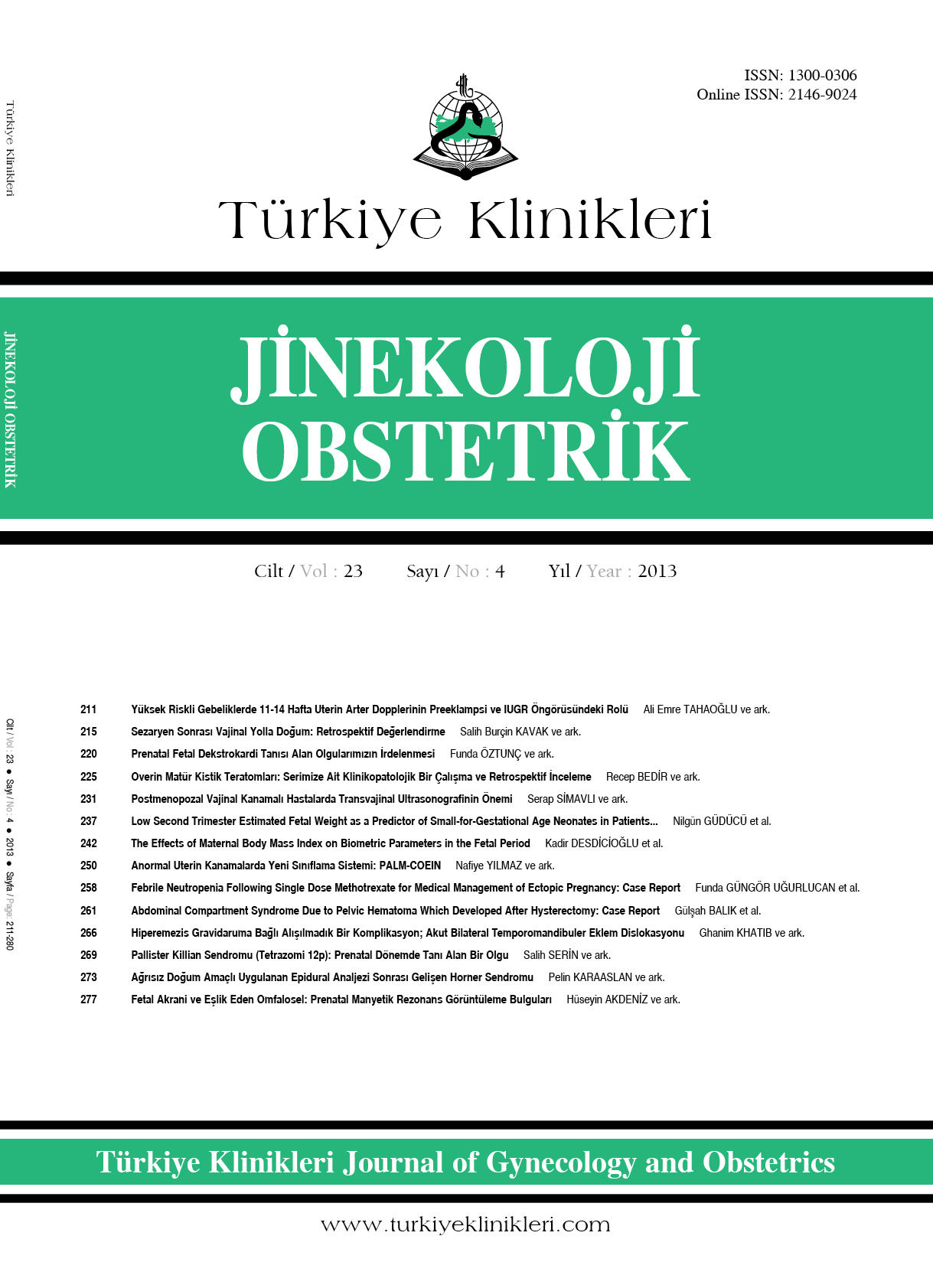Open Access
Peer Reviewed
CASE REPORTS
4431 Viewed1396 Downloaded
Fetal Acrania and Associated Omphalocele: Prenatal Magnetic Resonance Imaging Findings: Case Report
Fetal Akrani ve Eşlik Eden Omfalosel: Prenatal Manyetik Rezonans Görüntüleme Bulguları
Turkiye Klinikleri J Gynecol Obst. 2013;23(4):277-80
Article Language: TR
Copyright Ⓒ 2025 by Türkiye Klinikleri. This is an open access article under the CC BY-NC-ND license (http://creativecommons.org/licenses/by-nc-nd/4.0/)
ÖZET
Fetal akrani, nadir görülen kalvariyum kemiklerinin kısmi ya da tam yokluğu ve serebral hemisferlerin anormal gelişimi ile karakterize fatal konjenital bir anomalidir. Akraniye nöral tüp defektleri, omfalosel, karaciğer ve kalp anomalileri, yarık damak-dudak, ayak deformiteleri, mikroftalmi gibi diğer anomaliler eşlik edebilir. Fetal akrani hemen daima ölümcül bir anomalidir. Omfalosel (eksomfalos), karın içi organlarının periton ve amniyon ile çevrili olarak abdominal kavitenin dışında yer aldığı ve bu kesenin devamında göbek kordonunun olduğu en sık görülen karın ön duvar orta hat defektlerinden biridir. Bu makalede, prenatal dönemde periyodik takibe gelmemiş 17 haftalık bir gebede saptadığımız fetal akrani ve eşlik eden omfalosel olgusunun çekilen fetal manyetik rezonans görüntüleme bulgularını sunduk.
Fetal akrani, nadir görülen kalvariyum kemiklerinin kısmi ya da tam yokluğu ve serebral hemisferlerin anormal gelişimi ile karakterize fatal konjenital bir anomalidir. Akraniye nöral tüp defektleri, omfalosel, karaciğer ve kalp anomalileri, yarık damak-dudak, ayak deformiteleri, mikroftalmi gibi diğer anomaliler eşlik edebilir. Fetal akrani hemen daima ölümcül bir anomalidir. Omfalosel (eksomfalos), karın içi organlarının periton ve amniyon ile çevrili olarak abdominal kavitenin dışında yer aldığı ve bu kesenin devamında göbek kordonunun olduğu en sık görülen karın ön duvar orta hat defektlerinden biridir. Bu makalede, prenatal dönemde periyodik takibe gelmemiş 17 haftalık bir gebede saptadığımız fetal akrani ve eşlik eden omfalosel olgusunun çekilen fetal manyetik rezonans görüntüleme bulgularını sunduk.
ANAHTAR KELİMELER: Prenatal tanı; nöral tüp defektleri
ABSTRACT
Fetal acrania is a rare congenital anomaly and characterized by partial or complete absence of the calvarium with abnormal brain tissue development. Fetal acrania cases may be associated with neural tube defects, omphalocele, liver and heart abnormalities, cleft lip-palate, foot deformities and other anomalies such as microphtalmia. An omphalocele (also known as exomphalos) is a midline abdominal wall defect of variable size, with the herniated viscera covered by a membrane consisting of peritoneum on the inner surface, amnion on the outer surface, and Wharton's jelly between the layers. The umbilical vessels insert into the membrane and not the body wall. The hernia contents include a variable amount of intestine, often parts of the liver, and occasionally other organs. We report a fetal acrania and associated omphalocele prenatal magnetic resonance imaging (MRI) findings in the case which has not been not followed up during pregnancy at the 17th week of gestation.
Fetal acrania is a rare congenital anomaly and characterized by partial or complete absence of the calvarium with abnormal brain tissue development. Fetal acrania cases may be associated with neural tube defects, omphalocele, liver and heart abnormalities, cleft lip-palate, foot deformities and other anomalies such as microphtalmia. An omphalocele (also known as exomphalos) is a midline abdominal wall defect of variable size, with the herniated viscera covered by a membrane consisting of peritoneum on the inner surface, amnion on the outer surface, and Wharton's jelly between the layers. The umbilical vessels insert into the membrane and not the body wall. The hernia contents include a variable amount of intestine, often parts of the liver, and occasionally other organs. We report a fetal acrania and associated omphalocele prenatal magnetic resonance imaging (MRI) findings in the case which has not been not followed up during pregnancy at the 17th week of gestation.
MENU
POPULAR ARTICLES
MOST DOWNLOADED ARTICLES





This journal is licensed under a Creative Commons Attribution-NonCommercial-NoDerivatives 4.0 International License.










